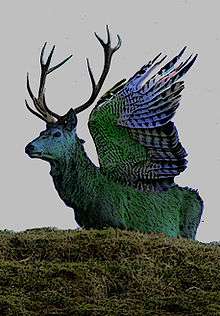Peryton

The Peryton is an alleged mythological hybrid animal combining the physical features of a stag and a bird. The Peryton was created and described by Jorge Luis Borges in his Book of Imaginary Beings, using a supposedly long-lost medieval manuscript as a source.
Mythology
The Peryton is said to have the head, neck, forelegs and antlers of a stag, combined with the plumage, wings and hindquarters of a large bird, although some interpretations portray the Peryton as a deer in all but coloration and bird's wings.
According to Borges, Perytons lived in Atlantis until an earthquake destroyed the civilization and the creatures escaped by flight. A Peryton casts the shadow of a man until it kills one during its lifetime, at which time it starts to cast its own shadow. A Sibyl once prophesied that the Perytons would lead to the downfall of Rome.[1]
In Borges' original Spanish edition, the word is given as peritio so the presumptive Latin original would be peritius, which happens to be the Latin name of the fourth month on the ancient Macedonian calendar,[2] (Peritios, moon of January). The connection of this, if any, to the peryton is unclear.
Popular culture
Perytons are found or used in modern literature and games.
Books and manga
- A Peryton closely matching Borges's original description is a minor villain in The Cinnabar Box, a fantasy novel by Ilil Arbel. Uniquely, this incarnation of the monster can use and understand human speech.[3]
- In the manga MÄR, the Peryton is a Guardian ÄRM that is owned by Ian. It has a monstrous form and it can shoot a beam out of its mouth similar to the Gargoyle form of Babbo.
- A Peryton is referred to in The Sword of the Lictor, a book in The Book of the New Sun series by Gene Wolfe. In the series, a constellation is also named after the beast.
- The creatures also appear in Darkwell, a book in the Moonshae Trilogy, where a flock of Perytons are among an army of evil monsters summoned by the book's main antagonist.[4]
- In a Donald Duck comic, "Mythological Menagerie," Donald Duck uses cardboard wings to disguise a normal deer as a Peryton to trick Huey, Dewey, and Louie.
- A herd of Perytons with golden fur and antlers laced with poison attack the main characters in the book Fablehaven: Secrets of the Dragon Sanctuary while fleeing a dragon.
- A murderous Peryton named Orfeo is a major villain in the fantasy novel Whiskey and Water by Elizabeth Bear.
- Swarms of cat-sized Perytons are natural enemies of the unicorns in Peter S. Beagle's fantasy novel The Unicorn Sonata.
- In the defunct Robotech storyline The Sentinels, Peryton is the homeworld of a race of horned, mutant energy-wizards called Perytonians. The species is humanoid with cone-shaped heads, horns, and two thumbs on each hand.
- The Peryton features in John and Carole Barrowman's novel Hollow Earth.[5]
- The Preyton found in Warhammer Forge's expansion book, Monstrous Arcanum, shares characteristics with the Peryton.[6]
- In the Kendra Kandlestar children's book series, Perytons are somewhat arrogant and keep to themselves. They refer to earth-bound beings as "underlings," but are herbivorous and pose no threat to humans or other creatures.
Games
- The Peryton is included among the bestiary of the game Dungeons and Dragons. Like the creature in Borges' book, it has the hindquarters of a large bird.
- The Peryton is included in the "Monsters of the Mind" subsection in the trading card game Weird and Wild Creatures.
- Perytons are enemies in the PlayStation 2 video game Tsugunai: Atonement.
- The Perytons are a monster creature in the tabletop game Warhammer, close in its look to the winged deer of the Sylvaneth army, though it keeps its malevolent attributes. Its only miniature is a resin set from Forge World
Science
- The term peryton is also used for radio signals of terrestrial origin that mimic fast radio bursts, pulses that appear to be coming from outside of our galaxy.[7] These perytons were found to be the result of premature opening of microwave oven doors, which releases a frequency-swept radio pulse, which mimics an FRB, as the magnetron turns off.[8]
See also
References
- ↑ Nigg, Joseph (2002). The Book of Dragons & Other Mythical Beasts (1st ed.). Hauppauge, NY: Barron's. p. 91. ISBN 9780764155109.
- ↑ Περίτιος
- ↑ Arbel, Ilil (2003-09-01). "The Cinnabar Box". ISBN 9781589394698.
- ↑ ASIN 0786935669
- ↑ Kelly, Charles (26 January 2011). "Hollow Earth - A Great Read and Brilliant Promotion for Cumbrae". S1millport.com. Retrieved 27 January 2011.
- ↑ "Preyton". Forge World. Retrieved 2015-04-13.
- ↑ Sarah Burke-Spolaor; Matthew Bailes; Ronald Ekers; Jean-Pierre Macquart; Fronefield Crawford III (2010). "Radio Bursts with Extragalactic Spectral Characteristics Show Terrestrial Origins". arXiv:1009.5392
 [astro-ph.CO].
[astro-ph.CO]. - ↑ Emily Petroff; E. F. Keane; E. D. Barr; J. E. Reynolds; J. Sarkissian; P. G. Edwards; J. Stevens; C. Brem; A. Jameson; Sarah Burke-Spolaor; S. Johnston; N. D. R. Bhat; P. Chandra; S. Kudale; S. Bhandari (2015). "Identifying the source of perytons at the Parkes radio telescope". arXiv:1504.02165
 [astro-ph.IM].
[astro-ph.IM].